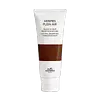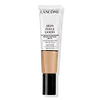What's inside
What's inside
 Key Ingredients
Key Ingredients

 Benefits
Benefits

 Concerns
Concerns

 Ingredients Side-by-side
Ingredients Side-by-side

Water
Skin ConditioningMethyl Trimethicone
Skin ConditioningNeopentyl Glycol Diethylhexanoate
EmollientMica
Cosmetic ColorantDimethicone
EmollientDipropylene Glycol
HumectantPEG-10 Dimethicone
Skin ConditioningCyclopentasiloxane
EmollientVinyl Dimethicone/Methicone Silsesquioxane Crosspolymer
Pentylene Glycol
Skin ConditioningButylene Glycol
HumectantGlycerin
HumectantPhenoxyethanol
PreservativeSorbitol
HumectantPolyglyceryl-2 Diisostearate
EmulsifyingSodium Citrate
BufferingTrimethylsiloxysilicate
EmollientDisteardimonium Hectorite
StabilisingSodium Chloride
MaskingParfum
MaskingCaprylic/Capric Triglyceride
MaskingTocopherol
AntioxidantDimethicone/Vinyl Dimethicone Crosspolymer
Skin ConditioningGlycine
BufferingBenzyl Salicylate
PerfumingSodium Hyaluronate
HumectantScutellaria Baicalensis Root Extract
AstringentLimonene
PerfumingOenothera Biennis Seed Extract
Skin ConditioningMorus Alba Bark Extract
Skin ConditioningGeraniol
PerfumingCitronellol
PerfumingLinalool
PerfumingHydroxycitronellal
PerfumingCI 77891
Cosmetic ColorantCI 77491
Cosmetic ColorantWater, Methyl Trimethicone, Neopentyl Glycol Diethylhexanoate, Mica, Dimethicone, Dipropylene Glycol, PEG-10 Dimethicone, Cyclopentasiloxane, Vinyl Dimethicone/Methicone Silsesquioxane Crosspolymer, Pentylene Glycol, Butylene Glycol, Glycerin, Phenoxyethanol, Sorbitol, Polyglyceryl-2 Diisostearate, Sodium Citrate, Trimethylsiloxysilicate, Disteardimonium Hectorite, Sodium Chloride, Parfum, Caprylic/Capric Triglyceride, Tocopherol, Dimethicone/Vinyl Dimethicone Crosspolymer, Glycine, Benzyl Salicylate, Sodium Hyaluronate, Scutellaria Baicalensis Root Extract, Limonene, Oenothera Biennis Seed Extract, Morus Alba Bark Extract, Geraniol, Citronellol, Linalool, Hydroxycitronellal, CI 77891, CI 77491
Water
Skin ConditioningGlycerin
HumectantCaprylyl Methicone
Skin ConditioningEthylhexyl Methoxycinnamate
UV AbsorberPropanediol
SolventDimethicone
EmollientRosa Gallica Flower Extract
AstringentSorbitol
HumectantTriethoxysilylethyl Polydimethylsiloxyethyl Dimethicone
Skin ConditioningDimethicone/PEG-10/15 Crosspolymer
Sodium Chloride
MaskingSodium Citrate
BufferingSodium Hyaluronate
HumectantMoringa Oleifera Seed Extract
Skin ConditioningAlumina
AbrasiveDisodium EDTA
Disodium Phosphate
BufferingIsopropyl Titanium Triisostearate
EmollientPropylene Glycol
HumectantDipropylene Glycol
HumectantCitric Acid
BufferingBHT
AntioxidantTocopherol
AntioxidantPhenoxyethanol
PreservativeChlorphenesin
AntimicrobialParfum
MaskingIron Oxides
CI 77891
Cosmetic ColorantWater, Glycerin, Caprylyl Methicone, Ethylhexyl Methoxycinnamate, Propanediol, Dimethicone, Rosa Gallica Flower Extract, Sorbitol, Triethoxysilylethyl Polydimethylsiloxyethyl Dimethicone, Dimethicone/PEG-10/15 Crosspolymer, Sodium Chloride, Sodium Citrate, Sodium Hyaluronate, Moringa Oleifera Seed Extract, Alumina, Disodium EDTA, Disodium Phosphate, Isopropyl Titanium Triisostearate, Propylene Glycol, Dipropylene Glycol, Citric Acid, BHT, Tocopherol, Phenoxyethanol, Chlorphenesin, Parfum, Iron Oxides, CI 77891
 Reviews
Reviews

Ingredients Explained
These ingredients are found in both products.
Ingredients higher up in an ingredient list are typically present in a larger amount.
Ci 77891 is a white pigment from Titanium dioxide. It is naturally found in minerals such as rutile and ilmenite.
It's main function is to add a white color to cosmetics. It can also be mixed with other colors to create different shades.
Ci 77891 is commonly found in sunscreens due to its ability to block UV rays.
Learn more about CI 77891Dimethicone is a type of synthetic silicone created from natural materials such as quartz.
What it does:
Dimethicone comes in different viscosities:
Depending on the viscosity, dimethicone has different properties.
Ingredients lists don't always show which type is used, so we recommend reaching out to the brand if you have questions about the viscosity.
This ingredient is unlikely to cause irritation because it does not get absorbed into skin. However, people with silicone allergies should be careful about using this ingredient.
Note: Dimethicone may contribute to pilling. This is because it is not oil or water soluble, so pilling may occur when layered with products. When mixed with heavy oils in a formula, the outcome is also quite greasy.
Learn more about DimethiconeDipropylene Glycol is a synthetically created humectant, stabilizer, and solvent.
This ingredient helps:
Dipropylene glycol is technically an alcohol, but it belongs to the glycol family (often considered part of the ‘good’ alcohols). This means it is hydrating and gentle on skin unlike drying solvent alcohols like denatured alcohol.
As a masking agent, Dipropylene Glycol can be used to cover the smell of other ingredients. However, it does not have a scent.
Studies show Dipropylene Glycol is considered safe to use in skincare.
Learn more about Dipropylene GlycolGlycerin is already naturally found in your skin. It helps moisturize and protect your skin.
A study from 2016 found glycerin to be more effective as a humectant than AHAs and hyaluronic acid.
As a humectant, it helps the skin stay hydrated by pulling moisture to your skin. The low molecular weight of glycerin allows it to pull moisture into the deeper layers of your skin.
Hydrated skin improves your skin barrier; Your skin barrier helps protect against irritants and bacteria.
Glycerin has also been found to have antimicrobial and antiviral properties. Due to these properties, glycerin is often used in wound and burn treatments.
In cosmetics, glycerin is usually derived from plants such as soybean or palm. However, it can also be sourced from animals, such as tallow or animal fat.
This ingredient is organic, colorless, odorless, and non-toxic.
Glycerin is the name for this ingredient in American English. British English uses Glycerol/Glycerine.
Learn more about GlycerinParfum is a catch-all term for an ingredient or more that is used to give a scent to products.
Also called "fragrance", this ingredient can be a blend of hundreds of chemicals or plant oils. This means every product with "fragrance" or "parfum" in the ingredients list is a different mixture.
For instance, Habanolide is a proprietary trade name for a specific aroma chemical. When used as a fragrance ingredient in cosmetics, most aroma chemicals fall under the broad labeling category of “FRAGRANCE” or “PARFUM” according to EU and US regulations.
The term 'parfum' or 'fragrance' is not regulated in many countries. In many cases, it is up to the brand to define this term.
For instance, many brands choose to label themselves as "fragrance-free" because they are not using synthetic fragrances. However, their products may still contain ingredients such as essential oils that are considered a fragrance by INCI standards.
One example is Calendula flower extract. Calendula is an essential oil that still imparts a scent or 'fragrance'.
Depending on the blend, the ingredients in the mixture can cause allergies and sensitivities on the skin. Some ingredients that are known EU allergens include linalool and citronellol.
Parfum can also be used to mask or cover an unpleasant scent.
The bottom line is: not all fragrances/parfum/ingredients are created equally. If you are worried about fragrances, we recommend taking a closer look at an ingredient. And of course, we always recommend speaking with a professional.
Learn more about ParfumPhenoxyethanol is a preservative that has germicide, antimicrobial, and aromatic properties. Studies show that phenoxyethanol can prevent microbial growth. By itself, it has a scent that is similar to that of a rose.
It's often used in formulations along with Caprylyl Glycol to preserve the shelf life of products.
Chances are, you eat sodium chloride every day. Sodium Chloride is also known as table salt.
This ingredient has many purposes in skincare: thickener, emulsifier, and exfoliator.
You'll most likely find this ingredient in cleansers where it is used to create a gel-like texture. As an emulsifier, it also prevents ingredients from separating.
There is much debate on whether this ingredient is comedogenic. The short answer - comedogenic ratings don't tell the whole story. Learn more about comegodenic ratings here.
The concensus about this ingredient causing acne seems to be divided. Research is needed to understand if this ingredient does cause acne.
Scrubs may use salt as the primary exfoliating ingredient.
Learn more about Sodium ChlorideSodium Citrate is the sodium salts of citric acid. In skincare, it is used to alter pH levels and acts as a preservative.
Its main functions are to maintain the pH of a product and neutralize metal ions.
The acidity of our skin is maintained by our glands and skin biome; normal pH level of skin is slightly acidic (~4.75-5.5).
Being slightly acidic allows our skin to create an "acid mantle". This acid mantle is a thin barrier that protects our skin from bacteria and contaminants.
Learn more about Sodium CitrateSodium Hyaluronate is hyaluronic acid's salt form. It is commonly derived from the sodium salt of hyaluronic acid.
Like hyaluronic acid, it is great at holding water and acts as a humectant. This makes it a great skin hydrating ingredient.
Sodium Hyaluronate is naturally occurring in our bodies and is mostly found in eye fluid and joints.
These are some other common types of Hyaluronic Acid:
Learn more about Sodium HyaluronateSorbitol is a sugar alcohol. It is a hydrating and moisturizing agent created from the reduction process of glucose.
Most sorbitol is usually made from potato starch. It is also found in fruits such as apples and pears.
As a humectant, Sorbitol helps draw water to the skin. This helps keep the skin hydrated. Sorbitol also helps create a thicker texture in products. You might find sorbitol in your toothpaste and other gels.
It is a non-irritating ingredient that is great for those with dry skin.
Sorbitol is a prebiotic. It helps promote the growth of healthy bacteria on your skin. The bacteria on your skin form a microbiome. This microbiome helps protect your skin from infection and harmful bacteria.
Learn more about SorbitolTocopherol (also known as Vitamin E) is a common antioxidant used to help protect the skin from free-radicals and strengthen the skin barrier. It's also fat soluble - this means our skin is great at absorbing it.
Vitamin E also helps keep your natural skin lipids healthy. Your lipid skin barrier naturally consists of lipids, ceramides, and fatty acids. Vitamin E offers extra protection for your skin’s lipid barrier, keeping your skin healthy and nourished.
Another benefit is a bit of UV protection. Vitamin E helps reduce the damage caused by UVB rays. (It should not replace your sunscreen). Combining it with Vitamin C can decrease sunburned cells and hyperpigmentation after UV exposure.
You might have noticed Vitamin E + C often paired together. This is because it is great at stabilizing Vitamin C. Using the two together helps increase the effectiveness of both ingredients.
There are often claims that Vitamin E can reduce/prevent scarring, but these claims haven't been confirmed by scientific research.
Learn more about TocopherolWater. It's the most common cosmetic ingredient of all. You'll usually see it at the top of ingredient lists, meaning that it makes up the largest part of the product.
So why is it so popular? Water most often acts as a solvent - this means that it helps dissolve other ingredients into the formulation.
You'll also recognize water as that liquid we all need to stay alive. If you see this, drink a glass of water. Stay hydrated!
Learn more about Water